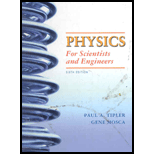
Concept explainers
(a)
Wave function of two waves.
(a)
Explanation of Solution
Given:
The wave function of standing wave is given as
Introduction:
The superimposed traveling waves have same wave number and same angular frequency. However, the amplitude of superimposed waves is equal and half the amplitude of the standing wave.
Write expression for the wave function for the wave traveling in positive x-direction.
Write expression for the wave function for the wave traveling in negative x-direction.
Conclusion:
Thus, the wave function for superimposed waves in positive and negative x-direction is given above.
(b)
The distance between nodes of the standing wave.
(b)
Explanation of Solution
Given:
The wave function of standing wave is given as
Formula used:
Write expression for wave number.
Rearrange above expression for
Write expression for distance between adjacent nodes.
Substitute
Calculation:
Substitute
Conclusion:
Thus, the distance between two waves is
(c)
The maximum speed of the rope at
(c)
Explanation of Solution
Given:
The wave function of standing wave is given as
Formula used:
Write expression for standing wave.
Calculation:
Differentiate equation (1) with respect to
Substitute
Substitute
Conclusion:
Thus, the maximum speed of the wave at
(d)
The maximum acceleration of the rope at
(d)
Explanation of Solution
Given:
The wave function of standing wave is given as
Formula used:
Write expression for standing wave.
Calculation:
Differentiate equation (1) with respect to
Differentiate above expression with respect to
Substitute
Conclusion:
Thus, maximum acceleration at
Want to see more full solutions like this?
Chapter 16 Solutions
PHYSICS F/SCI.+ENGRS.,STAND.-W/ACCESS
- Two sinusoidal waves with identical wavelengths and amplitudes travel in opposite directions along a string producing a standing wave. The linear mass density of the string is =0.075 kg/m and the tension in the string is FT=5.00 N. The time interval between instances of total destructive interference is t=0.13 s. What is the wavelength of the waves?arrow_forwardTwo sinusoidal waves are moving through a medium in the same direction, both having amplitudes of 3.00 cm, a wavelength of 5.20 m, and a period of 6.52 s, but one has a phase shift of an angle . What is the phase shift if the resultant wave has an amplitude of 5.00 cm? [Hint: Use the trig identity sinu+sinv=2sin(u+v2)cos(uv2)arrow_forwardConsider two sinusoidal sine waves traveling along a string, modeled as y1(x,t)=0.3msin(4m1x+3s1t+3) and y2(x,t)=0.6msin(8m1x6s1t) . What is the height of the resultant wave formed by the interference of the two waves at the position x=1.0 m at time t=3.0 s?arrow_forward
- Consider two wave functions that differ only by a phase shift, y1(x,t)=Acos(kxt) and y2(x,t)=Acos(kxt+) . Use the trigonometric cosu+cosv=2cos(uv2)cos(u+v2) and cos()=cos() to find a wave equation for the wave resulting from the superposition of the two waves. Does the resulting wave function come as a surprise to you?arrow_forwardA bat sends of a sound wave 100 kHz and the sound waves travel through air at a speed of v=343 m/s. (a) If the maximum pressure difference is 1.30 Pa, what is a wave function that would model the sound wave, assuming the wave is sinusoidal? (Assume the phase shift is zero.) (b) What are the period and wavelength of the sound wave?arrow_forwardGive one example of a transverse wave and one example of a longitudinal wave, being careful to note the relative directions of the disturbance and wave propagation in each.arrow_forward
- To increase the intensity of a wave by a factor of 50, by what factor should the amplitude be increased?arrow_forwardGiven the wave functions y1(x,t)=Asin(kxt) and y2(x,t)=Asin(kxt+) with 2 , show that y1(x,t)+y2(x,t) is a solution to the linear wave equation with a wave velocity of v=k .arrow_forwardA sound wave of a frequency of 2.00 kHz is produced by a string oscillating in the n=6 mode. The linear mass density of the string is =0.0065 kg/m and the length of the string is 1.50 m. What is the tension in the string?arrow_forward
- A string with a mass of 0.30 kg has a length of 4.00 m. If the tension in the string is 50.00 N, and a sinusoidal wave with an amplitude of 2.00 cm is induced on the string, what must the frequency be for an average power of 100.00 W?arrow_forwardCheck Your Understanding The equations for the wavelengths and the frequencies of the modes of a wave produced on a string: n=2nLn=1,2,3,4,5...andn=nv2L=nf1n=1,2,3,4,5... were derived by considering a wave on a string where there were symmetric boundary conditions of a node at each end. These modes resulted from two sinusoidal waves with identical characteristics except they were moving in opposite directions, confined to a region L with nodes required at both ends.Will the same equations work if there were symmetric boundary conditions with antinodes at each end? What would the normal modes look like for a medium that was free to oscillate on each end? Don’t worry for now if you cannot imagine such a medium, just consider two sinusoidal wave functions in a region of length L, with antinodes on each end.arrow_forwardConsider two wave functions y(x,t)=0.30cmsin(3m1x4s1t) and y(x,t)=0.30cmsin(3m1x+4s1t) . Write a wave function for the resulting standing wave.arrow_forward
 Physics for Scientists and Engineers: Foundations...PhysicsISBN:9781133939146Author:Katz, Debora M.Publisher:Cengage Learning
Physics for Scientists and Engineers: Foundations...PhysicsISBN:9781133939146Author:Katz, Debora M.Publisher:Cengage Learning Principles of Physics: A Calculus-Based TextPhysicsISBN:9781133104261Author:Raymond A. Serway, John W. JewettPublisher:Cengage Learning
Principles of Physics: A Calculus-Based TextPhysicsISBN:9781133104261Author:Raymond A. Serway, John W. JewettPublisher:Cengage Learning University Physics Volume 1PhysicsISBN:9781938168277Author:William Moebs, Samuel J. Ling, Jeff SannyPublisher:OpenStax - Rice University
University Physics Volume 1PhysicsISBN:9781938168277Author:William Moebs, Samuel J. Ling, Jeff SannyPublisher:OpenStax - Rice University Classical Dynamics of Particles and SystemsPhysicsISBN:9780534408961Author:Stephen T. Thornton, Jerry B. MarionPublisher:Cengage Learning
Classical Dynamics of Particles and SystemsPhysicsISBN:9780534408961Author:Stephen T. Thornton, Jerry B. MarionPublisher:Cengage Learning Glencoe Physics: Principles and Problems, Student...PhysicsISBN:9780078807213Author:Paul W. ZitzewitzPublisher:Glencoe/McGraw-Hill
Glencoe Physics: Principles and Problems, Student...PhysicsISBN:9780078807213Author:Paul W. ZitzewitzPublisher:Glencoe/McGraw-Hill




